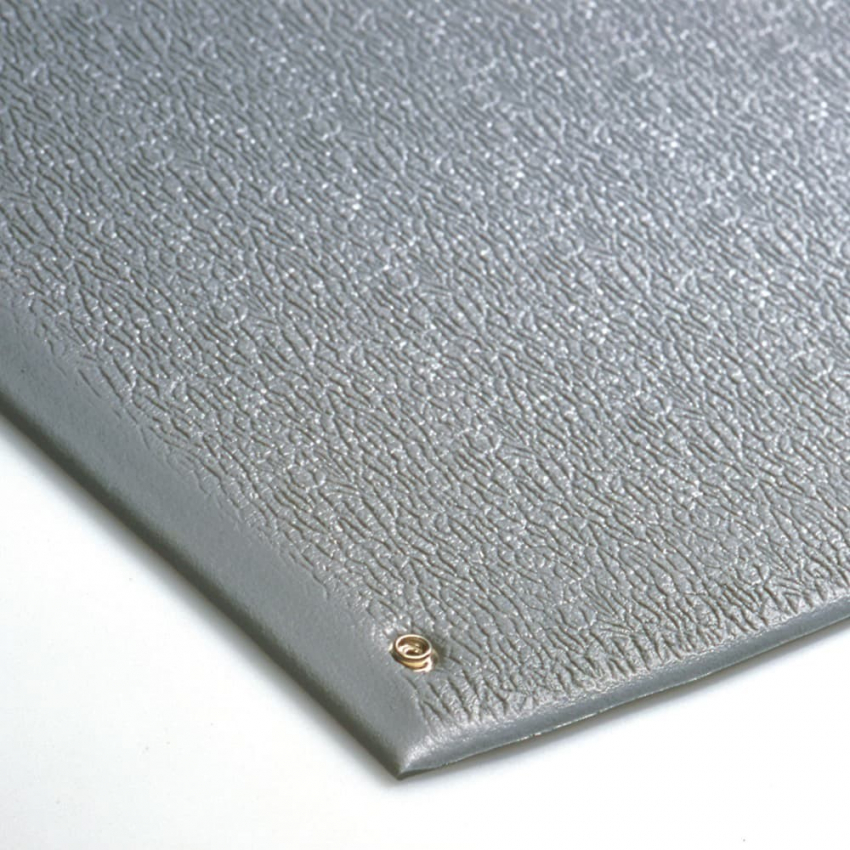








ESD matting protects users and sensitive equipment from the build-up of electrical charges: by evacuating electricity accumulated by surrounding objects or users. In addition to its anti-static properties, this mat also contains anti-fatigue properties: it helps reduce fatigue linked to prolonged standing.
However, this mat should not be used in high-voltage areas above 240V. Grounding is by means of a male latch (Ø 10mm) attached to the mat.
Available in standard and roll sizes .
PVC is resistant to many different chemicals, alkalis and general industrial chemicals. PVC resists alcohol, aliphatic hydrocarbons, oils, weak acids, strong mineral acids and alkalis . PVC is resistant to oil and grease, if properly cleaned. PVC is not resistant to organic solvents, ketones, esters and aromatic hydrocarbons. Please contact us for more specific details.
Fire resistance: Conforms to FMVSS 302. Will not burn after ignition source is removed. When "forced" to burn, fumes of Carbon Monoxide, Carbon Dioxide and Hydrogen Chloride are emitted.
Cleaning: Brush or wash top surface.
In dry indoor environments, loose-laid.
Around machines where static build-up is frequent. Do not use in high-voltage areas above 240 volts.

| AS060001 |
Data sheet
| Format | Mat Roller |
| Surface | granular |
| Location | Interior |
| Properties | Anti-fatigue ESD / AS |
| Composition | open cell PVC foam |
| Thickness | 9 mm |
| Resistant to chemicals | Yes |
| Maintenance / Cleaning | Brush or wash the top surface |
| Environment | Dry environments |
| Operating temperature | 0 °C to +60 °C |
| Intensity of use | Intense |
| Wear index | 2/3 (Very good) |
Industrial mats meet the needs of ergonomic workstations and employee well-being.
They prevent:
There are many uses for industrial mats:
Safety criteria: The mat must cover the entire workstation, be firmly attached to the floor, not shift or slide, and have bevelled edges to prevent falls.
Thickness and flexibility criteria: Contrary to what you might think, you shouldn't choose a very thick or very soft mat. The mat should have a certain elasticity, but still allow a comfortable standing position, without the user feeling slumped.
Environmental criteria :
Environmental hazard criteria : To establish more precise characteristics for a mat (antistatic properties or fire resistance etc...) we need to take into account the hazards present in the environment where the mat will be installed.
Where hazardous liquids are present in the working environment, the anti-slip properties and chemical resistance of industrial mats should be taken into account. The presence of openings on mats to allow the evacuation of fluids is essential.
Traffic criteria: We need to take into account the traffic that takes place on the equipment: how many workers can walk on it? How often, etc., in order to choose the most suitable mat.
Prevent the many problems associated with poor workstation ergonomics: RSI, static shock, bacterial proliferation, etc.
We offer a wide choice of industrial mats: on rolls, in standard sizes, made-to-measure or modular mats to suit all types of workstations.